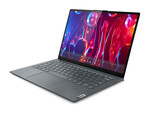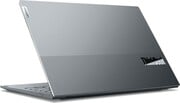Lenovo ThinkBook 13x ITG-20WJ001HGE
Spécifications de l'ordinateur portable

Price comparison
Moyenne de 6 notes (à partir de 7 critiques)
Critiques pour le/la Lenovo ThinkBook 13x ITG-20WJ001HGE
Source: XDA Developers
 EN→FR
EN→FRGiven that this thing barely costs over a thousand dollars in this configuration, it’s a solid buy. The Lenovo ThinkBook 13x is just so good. It’s thin, light, and compact, making it easy to go wherever with you. And it’s stylish in it’s two-tone silver color. The biggest drawbacks are the 720p webcam and that battery life doesn’t really stand out. As long as you can live with those things, I don’t know what else you’re looking for. The thing is that this is just great all-around. It doesn’t have some flashy new features or anything like that. It just gets the job done, and the things that are critical to the core experience are great. To me, this feels like it’s key to the ThinkBook brand. If you’re a small business that can’t go in on buying 500 ThinkPads for a big building full of employees, you’re probably looking at something like this. If you are, it checks just the right boxes.
Critique simple, disponibles en ligne, De taille moyenne, Date: 01/14/2022
Source: Laptop Mag
 EN→FR Archive.org version
EN→FR Archive.org versionThe ThinkBook 13x is a young whippersnapper that thought it could steal its predecessor’s shine, but the ThinkBook 13s Gen 2 is superior in many ways. It has a better variety of ports, zippier performance and quicker video transcoding. On top of that, its battery runtime is slightly longer. Of course, the ThinkBook 13s Gen 2 had its moments. It crushed its rivals in the file transfer, brightness and graphics tests. That being said, the ThinkBook 13s Gen 2 might be a better choice if that extra battery runtime boost matters to you. It’s also a decent option if you do some video transcoding here and there and you want a machine that saves you time. And if you dislike dongles, you’ll appreciate the ThinkBook 13s Gen 2’s wider variety of I/O options. Plus, it’s much cheaper than the ThinkBook 13x and serves up better processing performance (a ThinkBook 13s Gen 2 with an 11th Gen Core i5 CPU only costs $769 at Walmart). Still, the ThinkBook 13x has its niche audience.
Critique simple, disponibles en ligne, Longue, Date: 12/28/2021
Notes: Note globale: 80%
Source: Techaeris
 EN→FR Archive.org version
EN→FR Archive.org versionHonestly, I love the ThinkBook series from Lenovo, but it didn’t do it for me this year. And that’s only because of the battery life being so underwhelming. Even the previous ThinkBook we reviewed had better battery life. Other than that, I enjoyed reviewing the ThinkBook 13x.
Critique simple, disponibles en ligne, Longue, Date: 12/11/2021
Notes: Note globale: 90% prix: 85% performances: 95% écran: 90% mobilité: 75% finition: 100%
Source: Laptop Mag
 EN→FR Archive.org version
EN→FR Archive.org versionThe ThinkBook 13x is a young whippersnapper that thought it could steal its predecessor’s shine, but the ThinkBook 13s Gen 2 is superior in many ways. It has a better variety of ports, zippier performance and quicker video transcoding. On top of that, its battery runtime is slightly longer. Of course, the ThinkBook 13s Gen 2 had its moments. It crushed its rivals in the file transfer, brightness and graphics tests. That being said, the ThinkBook 13s Gen 2 might be a better choice if that extra battery runtime boost matters to you. It’s also a decent option if you do some video transcoding here and there and you want a machine that saves you time. And if you dislike dongles, you’ll appreciate the ThinkBook 13s Gen 2’s wider variety of I/O options. Plus, it’s much cheaper than the ThinkBook 13x and serves up better processing performance (a ThinkBook 13s Gen 2 with an 11th Gen Core i5 CPU only costs $769 at Walmart). Still, the ThinkBook 13x has its niche audience.
Critique simple, disponibles en ligne, Longue, Date: 12/06/2021
Notes: Note globale: 80%
Source: PC Mag
 EN→FR Archive.org version
EN→FR Archive.org versionThe Lenovo ThinkBook 13x is a capable ultraportable thanks to its lightweight design, productive 16:10 screen, and quality keyboard, touchpad, and speakers. It's reasonably priced and even comes with a Bluetooth mouse. But Lenovo might have shaved off a tenth of an inch too much from the similar ThinkBook 13s Gen 2, which has a better port selection and higher performance. Nonetheless, both ThinkBooks are worthy and economical alternatives to the premium-priced Dell XPS 13 and Razer Book 13.
Critique simple, disponibles en ligne, Longue, Date: 11/23/2021
Notes: Note globale: 70%
Source: Digital Trends
 EN→FR Archive.org version
EN→FR Archive.org versionNo. The ThinkBook 13x is a nice laptop, but it’s currently incredibly overpriced and, even at a more reasonable cost, simply doesn’t warrant buying it over its (very slightly) larger sibling, the ThinkBook 13s.
Critique simple, disponibles en ligne, Longue, Date: 11/16/2021
Notes: Note globale: 60%
Source: Ultrabook Review
 EN→FR Archive.org version
EN→FR Archive.org versionWhether it’s for business or pleasure, this ThinkBook 13x checks most of the boxes that a typical user would want in a modern ultrabook. The premium craftsmanship, the good typing experience, and the punchy and practical 16:10 touchscreen are among the main selling points of this series, alongside the snappy everyday use experience and long battery life. On the other hand, the minimalistic IO and the finicky clickpad and wifi connection might steer some of you away, especially at the high prices that Lenovo demand for this series at this point.
Critique simple, disponibles en ligne, Longue, Date: 11/09/2021
Notes: Note globale: 80%
Commentaire
Intel Iris Xe G7 96EUs:
Carte graphique intégrée dans les SoCs Intel Tiger Lake G4 basés sur la nouvelle architecture Gen. 12 avec 96 EUs (Execution Units / Shader Cluster). La fréquence d'horloge dépend du modèle de processeur. Les puces Tiger Lake sont produites dans le processus moderne 10nm+ chez Intel.
Ces cartes devraient être capables de faire tourner tout les jeux d'aujourd'hui, mais la plupart d'entre eux uniquement en détails moyens ou faibles et avec des résolution basses. Les plus vieux jeux ou les jeux moins gourmands restent jouables avec de beaux graphismes.
>> Plus d'informations sont à trouver dans notre comparaison des cartes graphiques mobiles et ainsi que dans notre liste des Benchmarks affiliés.
i5-1130G7:
Processeur quadricœur basse consommation basé sur Tiger Lake pour les ordinateurs portables fins et légers. Les quatre cœurs tournent autour de 1,1 à 4 GHz. Fabriqué en 10nm+ chez Intel.
>> Plus d'informations sont à trouver dans notre comparaison des processeurs mobiles.




